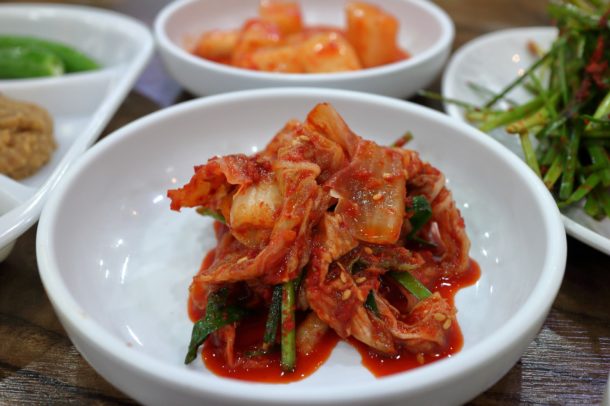Photo credit Image by 709 K from Pixabay
Submitted by Hanna Kim, Nutrition Student, and Dani Renouf, RD, MSc, CDE
One of the best aspects of Korean culture is the food. Korean cuisine consists of rice as a staple food, vegetables, stews, broths, meats, and a number of side dishes called banchan [1]. Kimchi, a fermented, spicy cabbage dish is served at almost every meal [2]. Did you know there are hundreds of different types of Kimchi? [4] What is more, they’re not all spicy! Traditionally, Korean food is often fermented, boiled, blanched, and pickled. Baking and/or frying are not common methods of cooking in korean cuisine [2]. The fermentation process enriches food flavors and preserves foods [2].
Common ingredients used in korean cooking include:
- Sesame oil (packed with omega-6 fatty acids, an essential fatty acid important for our health)
- Doenjang (fermented soybean paste)
- Soy sauce
- Salt
- Garlic
- Gochugaru (red chili pepper flakes)
- Gochujang (fermented red chili paste)
- Napa cabbage
- Salted shrimp
Is the sodium content in Korean food a concern?
The traditional South Korean diet is generally high in sodium [1]. According to the Korean Health Statistics in 2009, it has been shown that South Koreans consume around 4.6g of sodium per day and 2.5g of potassium per day [3]. The major sources of dietary sodium are from kimchi, soy sauce, and soybean paste [1]. For example, 1 cup of kimchi (150g), typically has around 747mg of sodium and 226mg of potassium [5][1] . However, the sodium content will depend on the brand of kimchi purchased, type, and how it’s made.
Tips to reduce sodium intake while eating Korean foods:
- Use less salt when cooking Korean foods: If you consistently cook korean food at home, start by reducing the amount of salt or seasonings like soy sauce you would normally add to your dishes.
- Smaller portion sizes: Instead of cutting out your favourite foods like kimchi out of your diet, try reducing the portion size
- Learn to season your food with herbs and spices: add flavour enhancers like garlic, ginger, scallions, and onions. Be creative and experiment with new and exciting flavors.
Navigating Korean Food:
Aim for plenty of grilled and/or steamed lean meats, poultry, white fish, and plant-proteins like tofu. Try incorporating many fresh and frozen fruits and vegetables into your diet. For example, fruits can include asian pears, apples, and berries. For vegetables, try incorporating more napa cabbage, radish (daikon), and lettuce into your diet.
Try this Korean-style white fish recipe below: (original recipe, used with permission from Davita.com)
Ingredients
• 1 tablespoon unseasoned rice vinegar
• 1 teaspoon reduced-sodium soy sauce
• 1 pound white fish fillets
• 3 tablespoons all-purpose white flour
• 1/2 teaspoon black pepper
• 2 large eggs
• 3 tablespoons sesame oil
Preparation
- Combine vinegar with soy sauce in a small bowl. Set aside until ready to serve fish.
- Rinse fish and pat dry with a paper towel. Cut each fish fillet into 1-1/2″ pieces.
- Place flour and pepper in a zip-top bag. Add fish, seal and shake to coat.
- In a small bowl, beat eggs lightly.
- Heat sesame oil in a large skillet.
- Dip each piece of flour-coated fish into beaten eggs to coat. Place in hot oil and fry until golden brown, turning once.
- Divide into 4 portions and serve hot. Sprinkle 1 teaspoon vinegar-soy sauce mixture on each portion.
Nutrients per serving
Calories 273
Protein 26 g
Carbohydrates 4 g
Fat 17 g
Cholesterol 151 mg
Sodium 134 mg
Potassium 400 mg
Phosphorus 359 mg
Calcium 42 mg
Fiber 0.1 g
Renal and renal diabetic food choices
• 3 meat
• 2 fat
REFERENCES:
[1] Lee, H. S., Duffey, K. J., & Popkin, B. M. (2013). Sodium and potassium intake patterns and trends in South Korea. Journal of human hypertension, 27(5), 298-303.
[2] Kim, S. H., Kim, M. S., Lee, M. S., Park, Y. S., Lee, H. J., Kang, S. A., & Lee, Y. E. (2016). Korean diet: characteristics and historical background. Journal of Ethnic Foods, 3(1), 26-31.
[3] Korea Centers for Disease Control and Prevention. (2012). Korea Health Statistics 2011: Korea National Health and Nutrition Examination Survey (KNHANES V‐2).
[4] Korea Tourism Organization. 2020. Kimchi. Retrieved from:
[5] USDA, Food Data Central. 2020. The FoodData Central Database. Retrieved from:
https://fdc.nal.usda.gov/fdc-app.html#/food-details/1103667/nutrients
